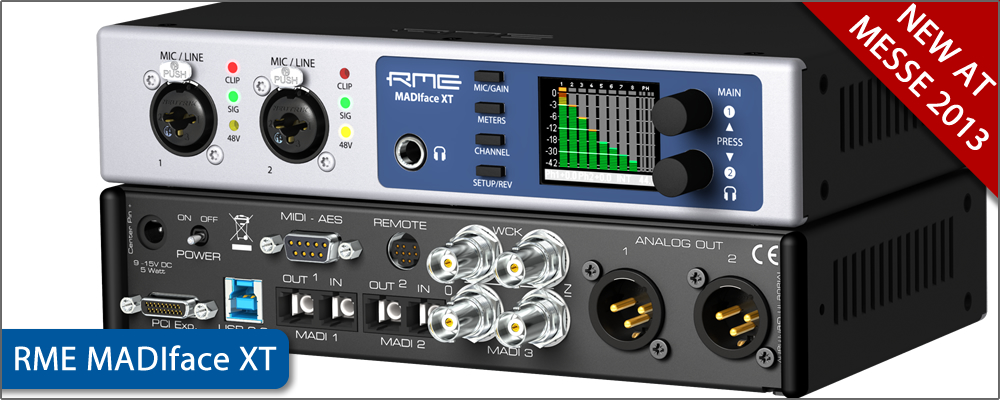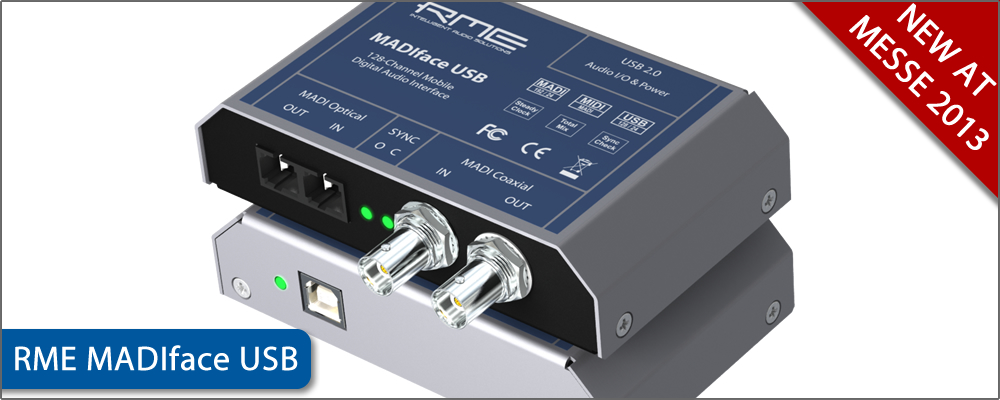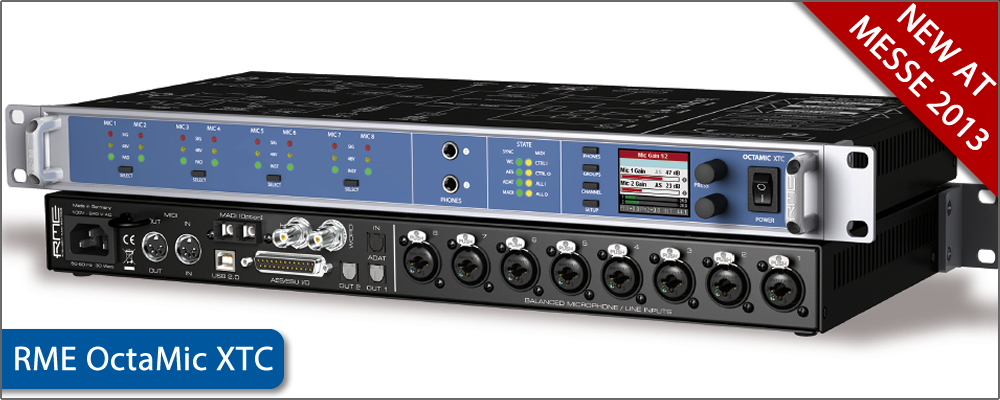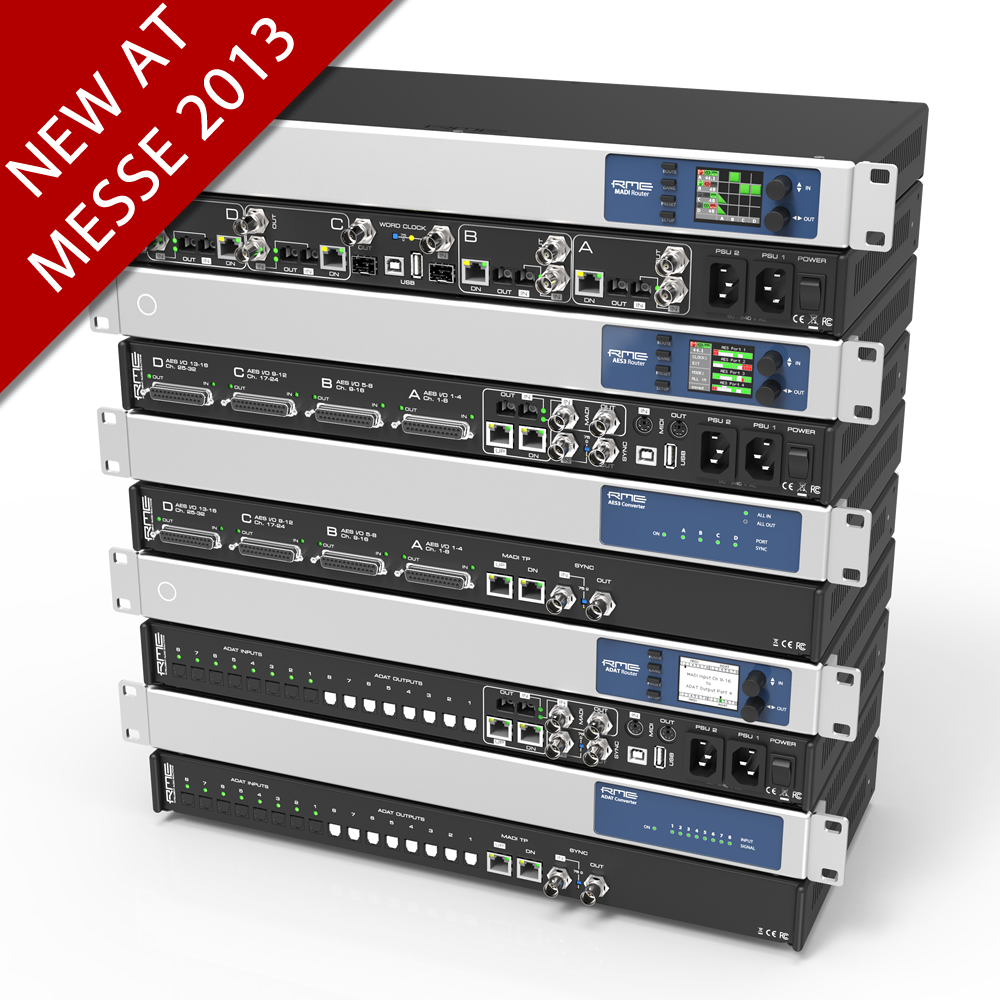 It looks like RME will be having one of their most exciting years at Frankfurt Musikmesse 2013 with the announcement of a whole array of new products including the TotalMix App.
It looks like RME will be having one of their most exciting years at Frankfurt Musikmesse 2013 with the announcement of a whole array of new products including the TotalMix App.
RME has long been recognised as the pioneer of MADI technology and their designers have always been committed to making the MADI protocol compatible, stable and affordable for their customers.
RME’s ADAT and AES3 converters (ADI-648, ADI-6432, ADI-648), interconnect solutions (MADI Bridge, MADI Converter) and computer interfaces (HDSP MADI, HDSPe MADI) have gained a reputation for being unmatched in terms of feature set and reliability for recording, live, broadcast, post-production and in places you wouldn’t expect. In over a decade RME made MADI more popular than any other manufacturer.
This year, RME introduces a complete new family of products: from the world’s first USB3 audio interface over the world’s most portable MADI solution to 5 new router/converter devices in a striking new design: the new MADI Router, the ADAT Router and ADAT Converter, and the AES3 Router and AES3 Converter.
A unique feature that all five products have on board is the new RJ45 connector for MADI, which extends the existing two media options, optical cables and coaxial cables, by a third one: standard networking cables. Making use of twisted pair Ethernet cables for multichannel audio signals brings along several advantages that optical and coaxial cables were lacking: bidirectional audio transmission between two devices over one cable, power supply, and unmatched availability of cables at a fraction of the cost compared to traditional MADI cabling. Depending on the type of cable, cable lengths of up to 100m (330 ft.) can be achieved.
So, let’s take a quick preview:
RME MADIface XT
The world‘s first USB3 audio interface
• 196 Input / 198 Output channels
• 2 x MADI I/O optical
• 1 x MADI I/O coaxial
• 2 x Analogue Mic / Line Preamp Input (XLR/Line TRS)
• 4 x Analogue Output (Main XLR + Phones)
• 1 x AES/EBU I/O via breakout cable
• 1 x MIDI I/O via breakout cable
• 3 x virtual MIDI I/O via the three MADI I/Os
The RME MADIface XT is the world’s first USB3 audio interface – and the world’s smallest portable interface that provides access to hundreds of audio channels in a highly portable package. For highest compatibility the XT also features a PCI Express port for connection to External PCI Express cards, providing the fastest interfacing technologies available for maximum channel count and lowest latency.
Three 64-channel MADI I/Os are accompanied by 4 MIDI I/Os, one stereo AES/EBU and a word clock I/O. To bring together the most complete I/O set for live or studio usage, two digitally controlled high-end mic/line preamps, two balanced line outputs and one stereo phones output, all fully 192kHz capable, were included. For perfect desktop operation RME’s (optional) Advanced Remote Control can be connected.
RME MADIface USB
Features:
• 64 input channels / 64 output channels
• 1 x MADI I/O (optical and coaxial)
• TotalMix
• No external power supply required
• Stand-alone Mode (repeater / format converter)
The MADIface USB is a compact device that provides MADI I/O via USB2 while supporting the format’s full 64 channels. Its sturdy and bus-powered design makes it as easy to use as reliable in operation. SteadyClock as well as RME’s well known MADI compatibility ensure hassle-free operation with other devices.
The optical and coaxial input offers RME’s Seamless Redundancy operation, switching between the two inputs in real-time if one of the signals fails. The optical and coaxial MADI outputs operate simultaneously.
The RME driver architecture for Mac and PC features TotalMix, a low latency 48bit internal mixer and routing matrix, and MIDI over MADI technology that may be used to remote-control other MADI devices. DIGICheck, an included complete audio analysing suite, supports the user under Mac OS X and Windows.
MADI Router
Unlimited flexibility for multichannel audio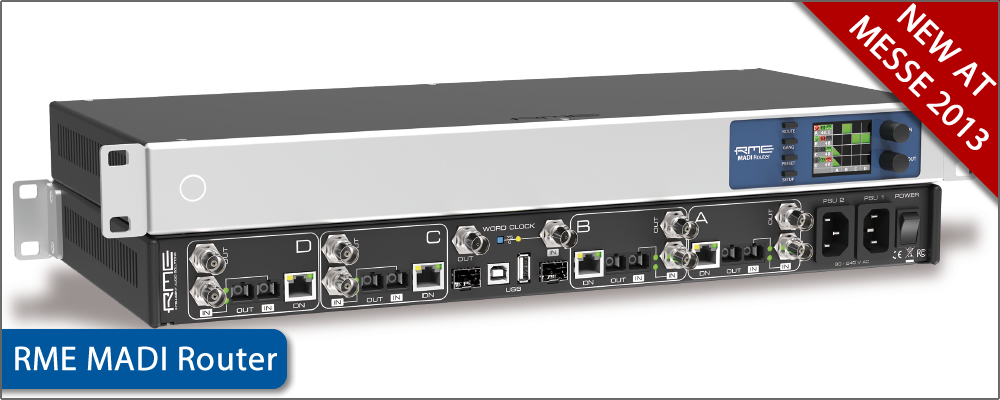
Features:
• 12 bridged MADI streams, including
• 4 composed MADI streams
• On-screen routing in 8-channel groups
• 12 MADI ports (4 x optical, 4 x coaxial, 4 x twisted pair)
• Redundant power supplies
• Word Clock I/O
• RME redundancy mode support
• USB connector for firmware updates and preset storage
The MADI Router has four groups of three different MADI I/Os each and may be used as a patch bay and format converter between those. Apart from the fully transparent, stream-wise operation between its ports it improves upon the well-known MADI Bridge by letting users create output signals that combine audio channels from different MADI inputs (“Any-to-any”).
The device is controlled directly at the unit, where a full-colour TFT display informs the user about the current input status and routing situation. Channels from any input group can be copied to different output groups in blocks, which ensures flexibility while maintaining clarity and easy access. Presets can be stored both on the device itself and on an attached USB memory stick.
RME AES3 Router
Splitting, combining and converting real-time signals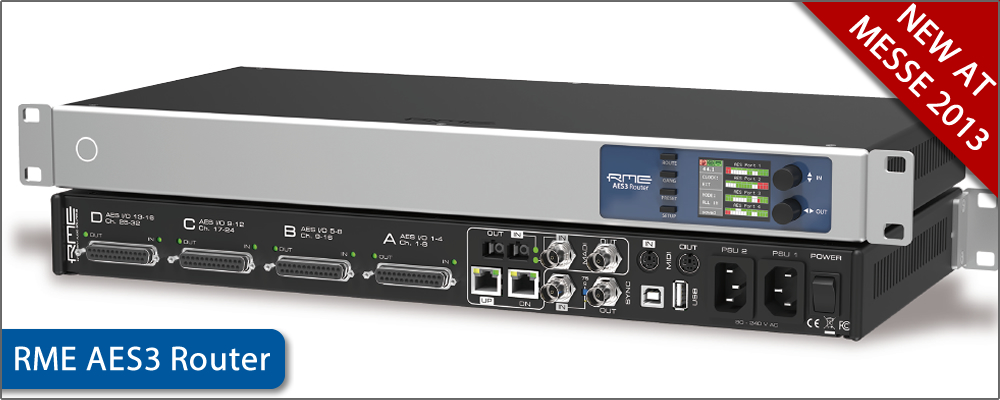
Features:
• 4 AES3 D-Sub connectors, configurable as: 32 audio I/O, or 64 audio inputs, or 64 audio outputs
• 4 MADI Ports (1 x optical, 1 x coaxial, 2 x twisted pair)
• MADI stream splitting for DS (96k) and QS (192k)
• MADI TP with power supply
• On-screen routing of individual channels
• MIDI In/Out for embedding/disembedding MIDI over MADI
• SYNC port accepting word clock or AES3 audio signals
• USB connector for firmware updates and preset storage
• Redundant power supplies
Following in the footsteps of the ADI-642 and ADI-6432, RME presents a device that takes the best of both units: channel-wise routing and multiple AES3/MADI conversion capabilities. Apart from optical, coaxial and twisted pair MADI connections, the AES3 Router provides four D-sub 25-pin ports, carrying 32 audio channels both in and out of the device. However, the ports can be configured to be send-only or receive-only ports, resulting in 64 audio channel outputs or 64 audio channel inputs.
The multiple MADI ports can be used as redundant outputs, or, if needed, as split outputs to accommodate AES3 signals with double or quad speed sampling rates.
All features can be conveniently controlled on the unit itself, where a menu guides the user easily through routing, storage and setup.
RME AES3 Converter
The perfect extension to a route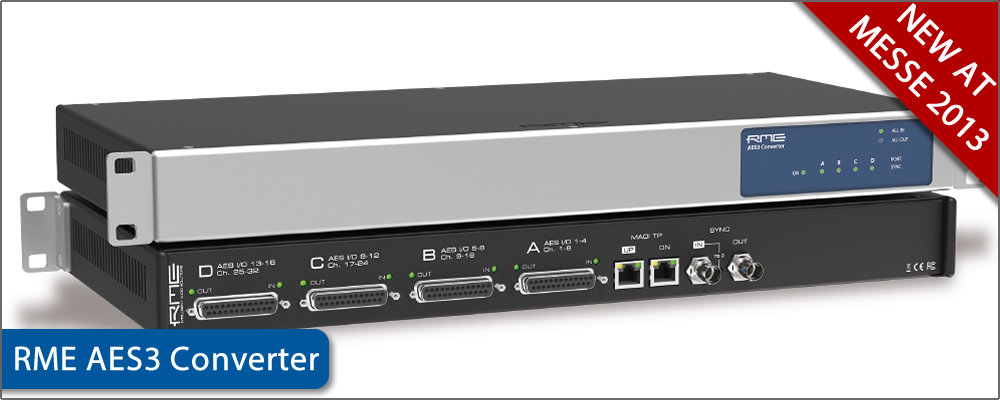
Features:
• 4 AES3 D-Sub connectors, configurable as:
> 32 audio inputs and outputs, or
> 64 audio inputs, or
> 64 audio outputs
• 2 x MADI TP ports receiving and passing through power
• Word clock I/O
The AES3 Converter is a great companion to either one of the routers. It provides the same flexible AES3 technology as the Router, however without routing capabilities and therefore the need for control.
Even though MADI TP is a bi-directional MADI port, there are two connectors at the unit: the first one is “up-stream” to the router, receiving synchronisation and power. The second one is “down-stream” to a second converter, providing the second unit with power and synchronisation. This way, the Router receives all signals from both Converters, while the Converters both receive the signals from the Router.
RME ADAT Router
Lightpipe meets MADI TP – channel-wise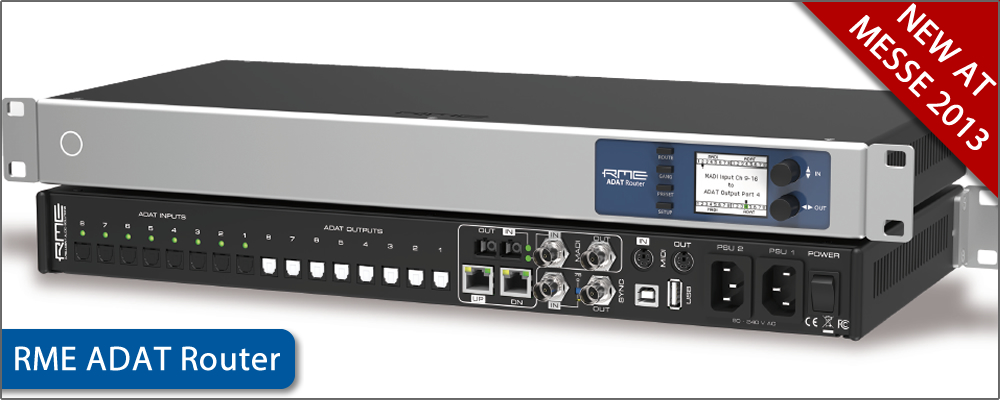
Features:
• 8 ADAT Lightpipe inputs (64 audio channels @48k)
• 8 ADAT Lightpipe outputs (64 audio channels @48k)
• 4 MADI Ports (1 x optical, 1 x coaxial, 2 x twisted pair)
• MADI TP with power supply
• On-screen routing of individual channels across MADI and ADAT
• MIDI In/Out for embedding/disembedding MIDI over MADI
• SYNC port accepting word clock or AES3 audio signals
• USB connector for firmware updates and preset storage
• Redundant power supplies
ADAT Lightpipe, originally designed by Alesis®, is an established standard for eight channel audio transmission over short optical cables. The ADAT Router acts as a gateway to the MADI world. It is based on the design of the ADI-648, providing eight optical ADAT inputs, eight ADAT outputs, and MADI connectors for optical, coaxial, and MADI Twisted Pair connections. All audio channels can be freely routed between MADI and ADAT.
Other than standard single speed applications, the ADAT Router is also capable of handling sample multiplexed ADAT signals (four channels at 96k / DS, two channels at 192k / QS per port) and merging them into a MADI stream.
RME ADAT Converter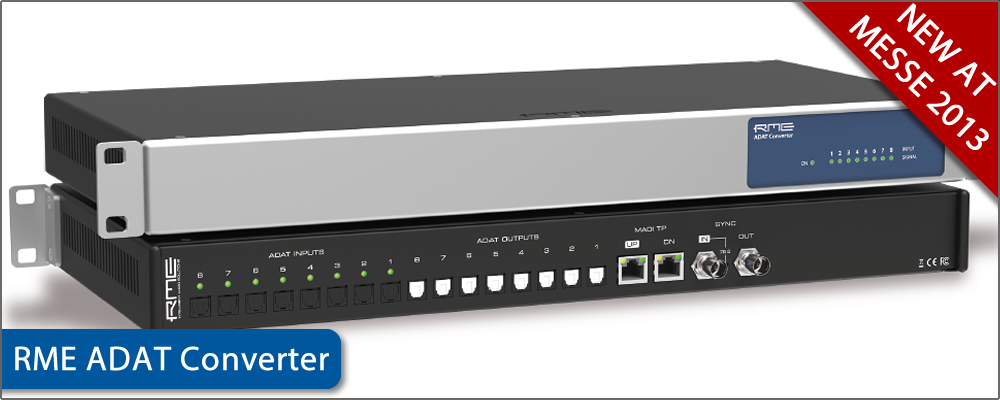
Zero configuration. 64 in, 64 out
Features:
• 8 ADAT Lightpipe inputs (64 audio channels @48k)
• 8 ADAT Lightpipe outputs (64 audio channels @48k)
• 2 x MADI TP ports receiving and passing through power
• SYNC port accepting word clock or AES3 audio signals
The ADAT Converter is an extension to either one of the routers, which provides the required power to this unit over the MADI Twisted Pair connection. Therefore, no additional power supply is needed.
The ADAT Converter translates the signals of up to eight ADAT inputs to MADI TP, and sends the signals from its MADI input to the eight ADAT outputs.
RME OctaMic XTC
Features:
• 8 x Mic/Line Preamps, digitally controlled (4 x PAD, 4 x Hi-Z switchable)
• 2 x Stereo Analogue Outputs
• 4 x AES/EBU I/O
• 1 x ADAT I/O (2 x out S/MUX)
• 1 x MADI I/O optical
• 1 x MIDI I/O DIN
• 2 x MIDI I/O USB
• 1 x MIDI over MADI
The OctaMic XTC is the swiss army knife among RME’s interfaces. An advanced eight channel microphone/line/instrument preamplifier with 192 kHz/24 bit A/D conversion and AutoSet, four channel D/A conversion for analog or digital input monitoring, and full MIDI remote control via USB, DIN and MADI were not enough to stop RME’s engineers. ADAT, AES and MADI optical operate as outputs as well as full-channel inputs, easily patched and routed with the comfortable TFT display – turning the XTC into a full blown digital format converter.
Quick access to all functions make the OctaMic XTC extremely fast and easy to set up. Its complete state can be saved and recalled from internal presets.
Back to top




















